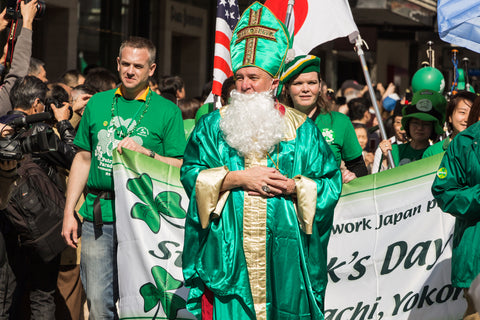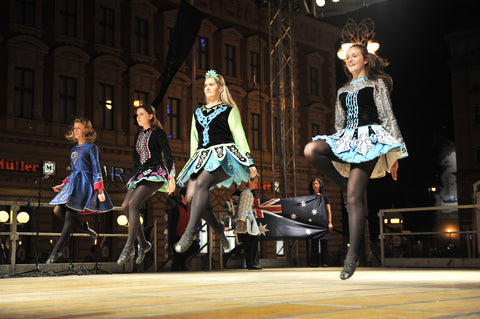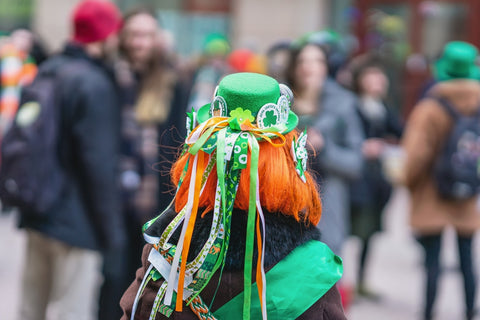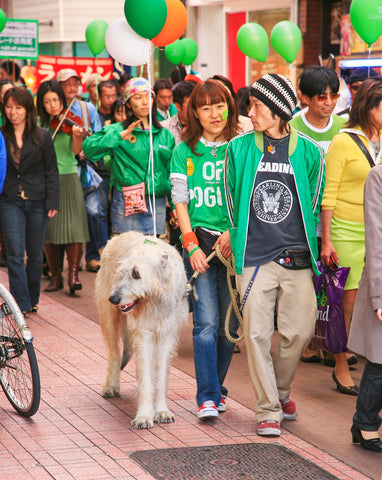Emerald Isles in the East: Celebrating St. Patrick’s Day in Japan

From the green fields of Ireland to the volcanic lands of Japan, St. Patrick’s Day is one of the only holidays that can successfully blend two distinct cultures. Despite having only a couple thousand Irish people, Japan seems to have embraced this foreign tradition wholeheartedly!
The Green Wave: St. Patrick’s Day’s Arrival in Japan

Originally a British holiday practiced in Ireland to celebrate their patron saint, St. Patrick’s Day first appeared in Japan in 1992, the year of the first parade. Since then, every year, on March 17, there has been a St. Patrick’s Day parade on the streets of Shibuya, Tokyo, except for a three-year suspension (2020-2022) due to COVID-19 restrictions.
Brief History of St. Patrick’s Day in Japan

It all started in 1957, when Japan became the first East Asian country to establish diplomatic relations with Ireland. This move laid the foundation for opening a resident embassy in Tokyo in 1973. Despite the good relations, there were barely a thousand Irish people in Japan. And in 1987, a small group of them joined forces to found the Irish Network Japan (INJ), a non-profit run by Irish and Japanese volunteers in the nation. The aim of the organization is to promote the seamless exchange of both cultures. One way to achieve this was to start Ireland’s most famous parade in Japan. So, on March 15, 1992, the INJ held Japan’s first Saint Patrick’s Day Parade in the Roppongi district of Tokyo. Today, the annual event is celebrated on March 17 along with other Irish festivals in the following 12 locations:
-
Osaka
-
Ise
-
Okinawa
-
Tokyo
-
Yokohama
-
Fukuoka
-
Kumamoto
-
Matsue
-
Nagoya
-
Chiba
-
Takamatsu
-
Okayama
What Saint Patrick’s Day Celebrations Mean to People in Japan

These celebrations keep Irish immigrants from feeling homesick, as they provide a display of culture and traditions they’re familiar with. It also promotes relations between the Irish and Japanese communities in the country. A typical St. Patrick’s Day parade in Tokyo sees thousands of people gather on the streets, irrespective of their nationalities. Most of them wear symbolic green attire ranging from modern to traditional dresses. You’ll find the celebrants waving both Japanese and Irish flags as they walk down the streets, while traditional Irish music plays loudly in the background.
Such festivals allow Irish people to connect with one another in a foreign land. The blending of cultures and traditions that takes place at these events also helps to foster peace and tolerance in the country. When Japan and Ireland faced each other in the 2019 Rugby World Cup, more people became aware of the presence of Irish people in the country. The 2002 FIFA World Cup, co-hosted by Japan, also had a similar impact.
The rest of this post takes a deeper dive into St. Patrick’s Day in Japan, exploring its different parade locations, cultural fusion, and other symbolic events.
Tokyo Turns Green: The Heart of St. Patrick’s Day in Japan

Tokyo is the most popular of the twelve St. Patrick’s Day parade locations in Japan. It was the location of the first one, and ever since then, it has been the site for the grand parade.
Omotesando Street is the most recent location for St. Patrick’s Day parades in Tokyo, including the 2024 event. It’s located in the Shibuya ward, a center for youthful shopping and pop culture in Japan. Getting to the street is easy if you stop at either Omotesando Station or Harajuku Station. From there, it’s only a five-minute walk to the parade ground.
A typical St. Patrick’s Day parade in Tokyo includes a display of studding green visuals, Irish dancers and marching bands, leprechauns, traditional outfits, and national flags. It’s filled with music, dancing, and laughter. Also, participants are generally of good behavior, making the parade a family-friendly event. Shamrock face-painting is a common activity along the parade route, with both kids and adults adorning their faces with bright green designs. People also show off their Irish wolfhound and setter dog breeds. After the parade, adults go to some of the Irish pubs in Tokyo to continue the celebrations at the after party. There, they eat beef stew and drink Irish beer to their heart's content.
Tokyo also plays a central role in other Irish festivities, including the Green Ireland Festival, which takes place on St. Patrick’s Day weekend. Formally known as the “I Love Ireland Festival,” it's the largest Irish festival in Asia and takes place in Yoyogi Park. There’s traditional music, live performances, Irish whiskey, food, drinks, and green lights! Unlike the St. Patrick’s Day parade, which takes place in different cities and countries, GIF is solely a Japanese celebration.
Osaka’s Vibrant Celebrations: A Touch of Irish Charm

St. Patrick’s Day in Osaka, Japan, is identical to that in Tokyo, although there are fewer participants because of the population difference. The parade takes place in Dotonbori, Osaka, and features all of the elements of St. Patrick’s Day one might expect.
The afterparty typically involves people celebrating through the night at local pubs or in their homes. Some of the pubs offer special drinks and food that combine Irish and Japanese cuisine. They also offer live music, dance performances, and themed events. Quick fact: Osaka happens to be the location of the first Irish pub in Japan, Murphy’s Irish Pub. It’s a popular spot for people celebrating St. Patrick’s Day in the city.
The Cultural Fusion: Irish and Japanese Traditions Merge

St. Patrick’s Day is celebrated in more than 200 countries. It’s only fair that there are some variations based on the location, some of which might come off strange to people already used to the original versions in Ireland. For instance, the St. Patrick’s Day celebration in Ise, Japan, displays a fascinating blend of Irish and Japanese cultural elements. Participants start their march at the Ise Shrine, a UNESCO intangible cultural heritage, to honor the Shinto sun goddess Amaterasu. The parade itself involves the flying of both Japanese and Irish national flags. You can see people hoisting portable shrines along the route. But it also includes the typical elements of Irish culture, such as dancing, bagpipes, and leprechaun costumes. Then there’s the food, which typically consists of a traditional meal of baked shellfish, Guinness float, and a mix of Japanese-Irish brews.
Another great example of cultural fusion is the establishment of GAA clubs in local communities. These clubs promote Irish culture in the country through Gaelic games like football, hurling, and handball. They consist of volunteers from different countries and backgrounds who participate in sporting events during celebrations, including St. Patrick’s Day.
Festivals and public parades are a big part of Japanese culture, which is why so many indigenous people are eager to honor the invitations from their Irish friends, coworkers, and business associates.
Parading in Green: The Signature St. Patrick’s Day Parades in Japan

St. Patrick’s Day parades are magnificent to watch. You’ll find participants wearing green clothes known as shamrocks. This is tied to an Irish folklore that suggests dorning green colors will protect you from mischievous leprechauns. Another belief is that the color brings good luck and honors the ancestors.
General participants at the parade include marching bands, cultural groups, charity organizations, fraternities, art students, voluntary groups, and the military. You’ll be treated to a spectacle of live dance performances, Irish traditional music sessions, and colorful floats. In terms of costumes, people come dressed as leprechauns, bears, rainbows, beer bottles, and even St. Patrick himself. Some of these attendees arrive at the parade with their Irish dog breeds, mainly wolfhounds and setters.
Irish Pubs in Japan: Celebratory Hubs on St. Patrick’s Day

Irish pubs in Japan serve as central gathering spots for St. Patrick’s Day. They offer Irish fare, drinks, and a lively atmosphere. Hence, these pubs are filled with festive customers after the end of the parade and on its weekend (Green Ireland Day). The common drinks served at these pubs include imported Guinness and Kilkenny brews. Irish whiskey is also a must-have at these joints, with Jameson, Redbreast, and other indigenous brands in stock. The festivities at the pubs also include foods like beef Wellington, buffalo wings, cabbage soup, and pie.
St. Patrick’s Festival Japan: A Week of Irish Culture

The St. Patrick’s Festival in Japan consists of two main celebratory days: St. Patrick’s Day and the Green Ireland Festival on the same weekend. While March 17 is usually reserved for spending time at the parade, the festival takes place on the weekend of that week, even if it falls a day before the parade. For example, March 16 is the day reserved for the Green Ireland Festival in 2024, a day before St. Patrick’s. Being one of the best festivals in Japan, it uses various attractions and activities to celebrate Irish culture, including art exhibitions, film screenings, and workshops. The location is Yoyogi Park, where the annual festival began.
Dancing to the Irish Beat: Traditional Music and Dance

Music and dance performances that are integral to St. Patrick’s Day celebrations in Japan. The Irish Network Japan and other voluntary bodies are usually responsible for inviting both local and international artists to these events. Several attendees have claimed that the music and dance performances were the highlights of the events. The music includes traditional folk songs and songs from contemporary artists. There are also song and dance performances by youth groups in the city. Watching people of different nationalities come together to perform the jig or step dance is a joy to behold, especially for Irish folk in the audience.
The Taste of Ireland: Sampling Irish Cuisine in Japan

St. Patrick’s Day festivals in Japan also serve as an opportunity for locals and immigrants to enjoy Irish cuisine. The best place to find Irish food on the day is at the local Irish pub. There are a lot of these all over town. These places are not only good for drinking beer or whiskey, even though they excel at that too. You can enjoy Irish beef, pork, and fish-based dishes, which appeal to both Japanese and Irish people. Examples of these meals are corn beef and cabbage okonomiyaki, ramen with chicken tikka and carbonara, or fusion sushi. If you’re lucky, you’ll find a lot of these fusion dishes sold at Japanese street food stalls on the evening of the parade.
Dressing in Green: Fashion and Costumes of St. Patrick’s Day

Earlier, we hinted at the widespread adoption of symbolic attire and thematic accessories for St. Patrick’s Day. Celebrations tend to feature green colored-attire, shamrock prints, and fun accessories related to Irish folklore. Below are some of the fashion trends and costumes that adorn the streets of Japan during St. Patrick’s Day:
-
Green glasses
-
Green hats
-
Leprechaun costumes
-
Rainbow costumes and accessories
-
Green shirts
-
Green necklace
Family-Friendly Festivities: St. Patrick’s Day for All Ages

St. Patrick’s Day in Japan is mostly a family-friendly affair, so feel free to take the kids to the parade ground for some wholesome fun. Below is our curated list of fun and exciting activities suitable for children and adults alike:
-
Visiting landmarks: The family can go on a trip to visit popular landmarks with associations to Ireland. One great choice is the Lafcadio Hearn Memorial Museum in Matsue, dedicated to the famous writer who used his works to explain Japanese traditions to the West.
-
Shamrock face-painting: Try out some of the shamrock face-painting spots available during the parade. Kids and adults can design their faces with green plants, rainbows, and more.
-
Making decorations: Children can spend time making cute decorations for the house and their clothes.
-
Eating Irish food: Take the family to visit child-friendly Irish restaurants in the area. You can also learn a recipe for Irish food and spend time making it together at home.
Beyond the Parade: Other St. Patrick’s Day Events in Japan

St. Patrick's Day never ends with the parade. Most times, special events that commemorate the holiday could go on for a week. The best way to immerse yourself in these events is to join a community. Many groups organize charity runs or cultural exchange gatherings on St. Patrick’s Day. You can attend them even if you’re not a member. Another great option is to join the local GAA club and participate in Gaelic games. Lastly, gift-giving on St. Patrick’s Day is said to bring good luck. Buy something nice for your friends, family, and colleagues.
The Impact on Tourism: St. Patrick’s Day as a Tourist Attraction

The enthusiastic celebration of St. Patrick’s Day in Japan is not only good for diplomatic relations but also drives tourism in the country. More Irish people are eager to visit the country and experience their take on the holiday. The families of expats also have a reason to visit the country in March and explore various attractions during their stay. Many of them come long before March 17 so they can participate in the most famous festivals of the first quarter, including the sapporo snow festival (celebration of snow and ice sculptures) and flower festivals (e.g., the cherry blossom festival). The more these people learn about Japan’s festive cultures, the more likely they’ll be to return for July’s Gion Matsuri and even autumn festival events (from September to December).
Embracing Global Traditions: The Future of St. Patrick’s Day in Japan

A symbol of global cultural exchange, St. Patrick’s Day is one of the best Japanese festivals. The parade in Tokyo is still the largest in Asia, and we don’t see that changing anytime soon. Although the number of Irish people in Japan is still relatively small and the Green Ireland Festival is not among the largest festivals in the country, its inclusivity will maintain the participant numbers for several years to come, especially now that the parade is back on after suspension due to COVID-19.
Do you know anyone who loves St. Patrick’s Day?
Visit Bokksu Boutique to pick out thoughtful and affordable gifts for them.
You can also get them a Snack Box subscription, which comes with a monthly supply of the tastiest Japanese treats.
Author Bio







 Bokksu Snack Box
Bokksu Snack Box

























